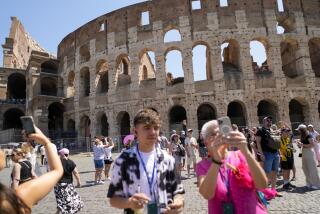The red at Rome’s Colosseum wasn’t just blood
ROME -- Archaeologists scraping away centuries of grime covering the walls of the Colosseum in Rome have discovered that the massive amphitheater was once painted with riotous colors.
Experts working on the walls of one of the corridors that once led Romans to their seats to watch bloody gladiatorial shows have discovered traces of brilliant reds, light blue, green and black, proving the drab gray stonework of the Colosseum was once a Technicolor feast.
Graffiti celebrating gladiatorial triumphs and scrawled phalluses also can be found on the plasterwork, which has been painstakingly revealed by scraping off dirt and dust.
“We have long suspected this range of colors was used. I have wanted to do this for 20 years,” said Rossella Rea, director of the Colosseum, the biggest Roman amphitheater ever built, which opened in 80 and hosted shows for half a millenium.
The discoveries were made in a corridor closed to the public, 60 feet above the level of the arena where gladiators battled, animals were hunted and fake sea battles were staged to please crowds of 50,000, as immortalized in the film “Gladiator.”
After a $106,000 clean-up, the corridor will be open to the public this summer, officials said.
Rea said Friday that the newly revealed colors were painted in the corridors that circled the arena, while the seating area was bright white, apart from the emperor’s luxury box, which was decked out in richly colored marble.
Rea’s team, garbed in “CSI”-style white boiler suits, also found symbols representing palm fronds and crowns painted on walls in the corridor, daubed by spectators to mark the victory in battle of a favorite gladiator. Experts have previously found images of gladiators scratched into the stone seating by spectators.
After about 500 years of bloodshed and entertainment, during which it survived a fire in the 3rd century, the Colosseum fell into disrepair. It was used for living quarters and even as a cemetery.
Graffiti now exposed from that period include scribbled names and phalluses -- “lots of phalluses,” said Rea. More recent signatures are dated 1826 and 1892, as curious visitors returned to the Colosseum.
Today, the site is showing its age. Fences have been erected to keep tourists from being hit by the pieces of travertine marble that have been falling from the exterior walls.
“Climate change means we are getting excessive heat, cold and rain, not to mention the pollution, which is damaging the marble,” said Rea, who added that the last real restoration work on the external stonework was 40 years ago.
A restoration program to protect the facade is due to get underway thanks to sponsorship from the Italian shoe manufacturer Tod’s, but has been bogged down by legal challenges.
“Once the scaffolding goes up for the restoration work, we will finally be able to get a close look at the facade and check to see if there are traces of color there,” said Rea. “If we find that the outside of the Colosseum was painted as well as the corridors, it would be an exceptional discovery.”
ALSO:
U.S., other nations question Algeria’s attack on gas plant
Critics gleefully pounce on Mexican president for verbal gaffe
Cameron: Fewer than 30 Britons still caught up in Algeria crisis
More to Read
Sign up for Essential California
The most important California stories and recommendations in your inbox every morning.
You may occasionally receive promotional content from the Los Angeles Times.










